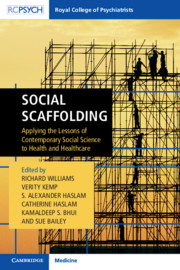Section 3 - Sourcing
Published online by Cambridge University Press: 14 June 2019
Summary
This chapter does two things. First, it shows how social identity principles can explain the basic psychological and behavioural effects of crowd membership. Second, it describes some recent research and applied work that shows how these basic effects operate to contribute to harmonious outcomes in potentially dangerous crowd events.
We begin by explaining some of the fundamental psychology of crowd membership in the next section.
- Type
- Chapter
- Information
- Social ScaffoldingApplying the Lessons of Contemporary Social Science to Health and Healthcare, pp. 129 - 212Publisher: Cambridge University PressPrint publication year: 2019



